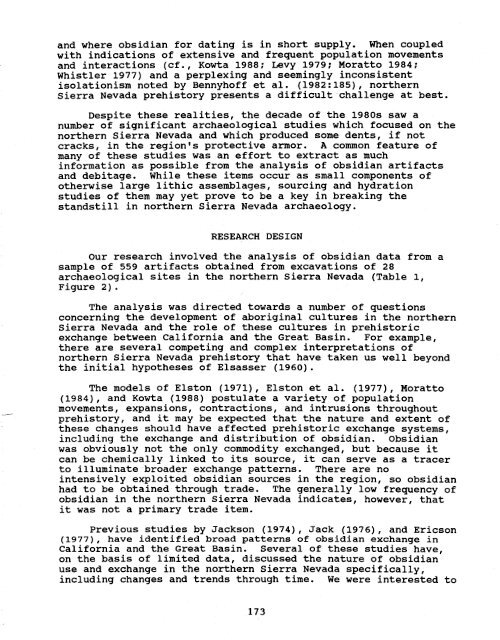regional prehistory and california-great basin - Society for California ...
regional prehistory and california-great basin - Society for California ...
regional prehistory and california-great basin - Society for California ...
Create successful ePaper yourself
Turn your PDF publications into a flip-book with our unique Google optimized e-Paper software.
<strong>and</strong> where obsidian <strong>for</strong> dating is in short supply. When coupled<br />
with indications of extensive <strong>and</strong> frequent population movements<br />
<strong>and</strong> interactions (cf., Kowta 1988; Levy 1979; Moratto 1984;<br />
Whistler 1977) <strong>and</strong> a perplexing <strong>and</strong> seemingly inconsistent<br />
isolationism noted by Bennyhoff et al. (1982:185), northern<br />
sierra Nevada <strong>prehistory</strong> presents a difficult challenge at best.<br />
Despite these realities, the decade of the 1980s saw a<br />
number of significant archaeological studies which focused on the<br />
northern Sierra Nevada <strong>and</strong> which produced some dents, if not<br />
cracks, in the region's protective armor. A common feature of<br />
many of these studies was an ef<strong>for</strong>t to extract as much<br />
in<strong>for</strong>mation as possible from the analysis of obsidian artifacts<br />
<strong>and</strong> debitage. While these items occur as small components of<br />
otherwise large lithic assemblages, sourcing <strong>and</strong> hydration<br />
studies of them may yet prove to be a key in breaking the<br />
st<strong>and</strong>still in northern Sierra Nevada archaeology.<br />
RESEARCH DESIGN<br />
Our research involved the analysis of obsidian data from a<br />
sample of 559 artifacts obtained from excavations of 28<br />
archaeological sites in the northern Sierra Nevada (Table 1,<br />
Figure 2).<br />
The analysis was directed towards a number of questions<br />
concerning the development of aboriginal cultures in the northern<br />
sierra Nevada <strong>and</strong> the role of these cultures in prehistoric<br />
exchange between Cali<strong>for</strong>nia <strong>and</strong> the Great Basin. For example,<br />
there are several competing <strong>and</strong> complex interpretations of<br />
northern Sierra Nevada <strong>prehistory</strong> that have taken us well beyond<br />
the initial hypotheses of Elsasser (1960).<br />
The models of Elston (1971), Elston et al. (1977), Moratto<br />
(1984), <strong>and</strong> Kowta (1988) postulate a variety of population<br />
movements, expansions, contractions, <strong>and</strong> intrusions throughout<br />
<strong>prehistory</strong>, <strong>and</strong> it may be expected that the nature <strong>and</strong> extent of<br />
these changes should have affected prehistoric exchange systems,<br />
including the exchange <strong>and</strong> distribution of obsidian. Obsidian<br />
was obviously not the only commodity exchanged, but because it<br />
can be chemically linked to its source, it can serve as a tracer<br />
to illuminate broader exchange patterns. There are no<br />
intensively exploited obsidian sources in the region, so obsidian<br />
had to be obtained through trade. The generally low frequency of<br />
obsidian in the northern Sierra Nevada indicates, however, that<br />
it was not a primary trade item.<br />
Previous studies by Jackson (1974), Jack (1976), <strong>and</strong> Ericson<br />
(1977), have identified broad patterns of obsidian exchange in<br />
Cali<strong>for</strong>nia <strong>and</strong> the Great Basin. Several of these studies have,<br />
on the basis of limited data, discussed the nature of obsidian<br />
use <strong>and</strong> exchange in the northern Sierra Nevada specifically,<br />
including changes <strong>and</strong> trends through time. We were interested to<br />
173
















